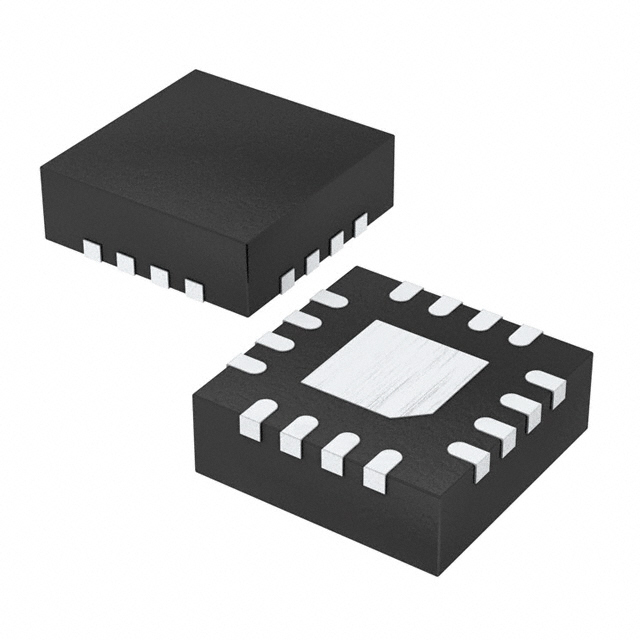Consulte las especificaciones para obtener detalles del producto.

PIC16F1823-E/ML
Introduction
The PIC16F1823-E/ML is a microcontroller belonging to the PIC16 family of microcontrollers produced by Microchip Technology. This entry provides an overview of the product, including its category, use, characteristics, package, essence, packaging/quantity, specifications, detailed pin configuration, functional features, advantages and disadvantages, working principles, detailed application field plans, and alternative models.
Product Overview
- Category: Microcontroller
- Use: The PIC16F1823-E/ML is designed for embedded control applications in various electronic devices, including consumer electronics, industrial automation, automotive systems, and more.
- Characteristics: It features low power consumption, high performance, and a wide range of peripherals, making it suitable for diverse applications.
- Package: The PIC16F1823-E/ML is available in a 20-pin QFN package.
- Essence: It is based on a powerful 8-bit RISC CPU with integrated flash memory.
- Packaging/Quantity: The PIC16F1823-E/ML is typically supplied in reels containing a specific quantity per reel.
Specifications
- CPU: 8-bit RISC
- Flash Memory: 3.5 KB
- RAM: 128 bytes
- Operating Voltage: 1.8V to 5.5V
- I/O Pins: 18
- Timers: 2 x 8-bit, 1 x 16-bit
- Analog-to-Digital Converter (ADC): 10-bit, 5 channels
- Communication Interfaces: SPI, I2C, UART
Detailed Pin Configuration
The PIC16F1823-E/ML features a 20-pin QFN package with specific pin assignments for power, ground, I/O, communication interfaces, and other peripherals. A detailed pinout diagram can be found in the product datasheet.
Functional Features
- Low Power Consumption: The microcontroller is designed for energy-efficient operation, making it suitable for battery-powered applications.
- Peripheral Integration: It offers a wide range of integrated peripherals, including timers, ADC, and communication interfaces, reducing the need for external components.
- Flexible I/O Configuration: The device supports configurable I/O pins, allowing for versatile interfacing with external components.
Advantages and Disadvantages
Advantages
- Low power consumption
- Integrated peripherals
- Flexible I/O configuration
Disadvantages
- Limited flash memory capacity
- Restricted number of I/O pins
Working Principles
The PIC16F1823-E/ML operates based on the 8-bit RISC architecture, executing instructions from its flash memory. It interacts with external components through its I/O pins and peripherals, enabling control and data processing in embedded systems.
Detailed Application Field Plans
The PIC16F1823-E/ML is well-suited for various applications, including: - Consumer Electronics: Remote controls, smart home devices - Industrial Automation: Sensor interfaces, motor control - Automotive Systems: Dashboard displays, lighting control
Detailed and Complete Alternative Models
- PIC16F1824-E/ML
- PIC16F1825-E/ML
- PIC16F1826-E/ML
These alternative models offer similar functionality and compatibility within the PIC16 family of microcontrollers.
In conclusion, the PIC16F1823-E/ML microcontroller from Microchip Technology offers a balance of performance, power efficiency, and integrated peripherals, making it suitable for a wide range of embedded control applications. Its compact package and flexible I/O configuration further enhance its versatility in various electronic designs.
Enumere 10 preguntas y respuestas comunes relacionadas con la aplicación de PIC16F1823-E/ML en soluciones técnicas
What is the maximum operating frequency of PIC16F1823-E/ML?
- The maximum operating frequency of PIC16F1823-E/ML is 32 MHz.Can PIC16F1823-E/ML be used for motor control applications?
- Yes, PIC16F1823-E/ML can be used for motor control applications with its integrated PWM module and analog-to-digital converter.Does PIC16F1823-E/ML support communication protocols like I2C or SPI?
- Yes, PIC16F1823-E/ML supports both I2C and SPI communication protocols.What are the available memory options for program storage in PIC16F1823-E/ML?
- PIC16F1823-E/ML offers 3.5 KB of Flash program memory and 128 bytes of data EEPROM.Can PIC16F1823-E/ML operate at low power?
- Yes, PIC16F1823-E/ML features multiple low-power modes to minimize power consumption.Is it possible to interface PIC16F1823-E/ML with external sensors?
- Yes, PIC16F1823-E/ML can interface with external sensors through its analog-to-digital converter and digital I/O pins.What development tools are available for programming PIC16F1823-E/ML?
- Development tools such as MPLAB X IDE and PICkit programmers can be used to program PIC16F1823-E/ML.Can PIC16F1823-E/ML be used in automotive applications?
- Yes, PIC16F1823-E/ML is suitable for automotive applications due to its wide operating voltage range and robust design.Are there any application notes or reference designs available for PIC16F1823-E/ML?
- Yes, Microchip provides application notes and reference designs for various technical solutions using PIC16F1823-E/ML.What are the available package options for PIC16F1823-E/ML?
- PIC16F1823-E/ML is available in a 20-pin QFN package and a 20-pin SSOP package.

